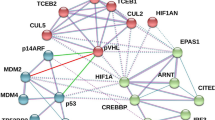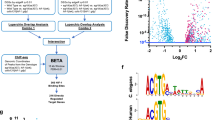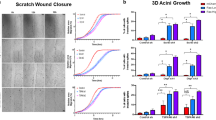Abstract
Regions of hypoxia are a hallmark of solid tumors. Tumor cells modulate the regulation of specific genes allowing adaptation and survival in the harsh hypoxic environment. We have identified SKIP3, a novel human kinase-like gene, which is overexpressed in multiple human tumors and is regulated by hypoxia. SKIP3 is an ortholog of the Drosophila tribbles, rat NIPK, dog C5FW, and human C8FW genes. Drosophila tribbles is involved in slowing cell-cycle progression during Drosophila development, but little is known regarding the function or tissue distribution of the vertebrate orthologs. We show that the normal tissue expression of SKIP3 is confined to human liver, while multiple primary human lung, colon, and breast tumors express high levels of SKIP3 transcript. Endogenous SKIP3 protein accumulates within 48 h under hypoxic growth conditions in HT-29 and PC-3 cells, with upregulation of the SKIP3 mRNA transcript by 72 h. We identified activating transcription factor 4 (ATF4) as a SKIP3-binding partner using the yeast-two-hybrid assay. Coexpression of SKIP3 and ATF4 showed that SKIP3 is associated with the proteolysis of ATF4, which can be blocked using a proteosome inhibitor. These results indicate that SKIP3 may be an important participant in tumor cell growth.
This is a preview of subscription content, access via your institution
Access options
Subscribe to this journal
Receive 50 print issues and online access
$259.00 per year
only $5.18 per issue
Buy this article
- Purchase on Springer Link
- Instant access to full article PDF
Prices may be subject to local taxes which are calculated during checkout









Similar content being viewed by others
References
Ausserer WA, Bourrat-Floeck B, Green CJ, Laderoute KR and Sutherland RM . (1994). Mol. Cell. Biol., 14, 5032–5042.
Butscher WG, Powers C, Olive M, Vinson C and Gardner K . (1998). J. Biol. Chem., 273, 552–560.
Eddy SR . (1996). Curr. Opin. Struct. Biol., 6, 361–365.
Estes SD, Stoler DL and Anderson GR . (1995). Exp. Cell Res., 220, 47–54.
Fafournoux P, Bruhat A and Jousse C . (2000). Biochem. J., 351, 1–12.
Fawcett TW, Martindale JL, Guyton KZ, Hai T and Holbrook NJ . (1999). Biochem. J., 339, 135–141.
Gachon F, Gaudray G, Thebault S, Basbous J, Koffi JA, Devaux C and Mesnard J . (2001). FEBS Lett., 502, 57–62.
Grosshans J and Wieschaus E . (2000). Cell, 101, 523–531.
Hai T and Curran T . (1991). Proc. Nat. Acad. Sci. USA, 88, 3720–3724.
Hai T and Hartman MG . (2001). Gene, 273, 1–11.
Hanks SK and Hunter T . (1995). FASEB J., 9, 576–596.
He CH, Gong P, Hu B, Stewart D, Choi ME, Choi AM and Alam J . (2001). J. Biol. Chem., 276, 20858–20865.
Hewes RS, Schaefer AM and Taghert PH . (2000). Genetics, 155, 1711–1723.
Hockel M and Vaupel P . (2001). J. Nat. Cancer Inst., 93, 266–276.
Karpinski BA, Morle GD, Huggenvik J, Uhler MD and Leiden JM . (1992). Proc. Nat. Acad. Sci. USA, 89, 4820–4824.
Kato Y, Koike Y, Tomizawa K, Ogawa S, Hosaka K, Tanaka S and Kato T . (1999). Mol. Cell. Endocrinol., 154, 151–159.
Kawai T, Matsumoto M, Takeda K, Sanjo H and Akira S . (1998). Mol. Cell. Biol., 18, 1642–1651.
Lal A, Peters H, St Croix B, Haroon ZA, Dewhirst MW, Strausberg RL, Kaanders JH, van der Kogel AJ and Riggins GJ . (2001). J. Nat. Cancer Inst., 93, 1337–1343.
Lassot I, Segeral E, Berlioz-Torrent C, Durand H, Groussin L, Hai T, Benarous R and Margottin-Goguet F . (2001). Mol. Cell. Biol., 21, 2192–2202.
Liang G and Hai T . (1997). J. Biol. Chem., 272, 24088–24095.
Masuoka HC and Townes TM . (2002). Blood, 99, 736–745.
Mata J, Curado S, Ephrussi A and Rorth P . (2000). Cell, 101, 511–522.
Mayumi-Matsuda K, Kojima S, Suzuki H and Sakata T . (1999). Biochem. Biophys. Res. Commun., 258, 260–264.
Nishizawa M and Nagata S . (1992). FEBS Lett., 299, 36–38.
Novoa I, Zeng H, Harding HP and Ron D . (2001). J. Cell Biol., 153, 1011–1022.
Reddy TR, Tang H, Li X and Wong-Staal F . (1997). Oncogene, 14, 2785–2792.
Rorth P, Szabo K and Texido G . (2000). Mol. Cell, 6, 23–30.
Saramaki OR, Savinainen KJ, Nupponen NN, Bratt O and Visakorpi T . (2001). Cancer Genet. Cytogenet., 128, 31–34.
Seher TC and Leptin M . (2000). Curr. Biol., 10, 623–629.
Semenza GL . (2000). Genes and Dev., 14, 1983–1991.
Tang K, Finley Jr RL, Nie D and Honn KV . (2000). Biochemistry, 39, 3185–3191.
Vallejo M, Ron D, Miller CP and Habener JF . (1993). Proc. Nat. Acad. Sci. USA, 90, 4679–4683.
Vinson CR, Hai T and Boyd SM . (1993). Genes Dev., 7, 1047–1058.
Wadle A, Thiel G, Mischo A, Jung V, Pfreundschuh M and Renner C . (2001). Oncogene, 20, 5920–5929.
Wilcox JN . (1993). J. Histochem. Cytochem., 41, 1725–1733.
Wilkin F, Suarez-Huerta N, Robaye B, Peetermans J, Libert F, Dumont JE and Maenhaut C . (1997). Eur. J. Biochem., 248, 660–668.
Yao KS, Clayton M and O'Dwyer PJ . (1995). J. Nat. Cancer Inst., 87, 117–122.
Yao KS, Xanthoudakis S, Curran T and O'Dwyer PJ . (1994). Mol. Cell. Biol., 14, 5997–6003.
Acknowledgements
We thank Marc Payton for providing the isolated total RNA from primary tumor samples for the TaqMan RT–PCR analysis and Tammy L Bush for providing the xenograft tumor material.
Author information
Authors and Affiliations
Corresponding author
Rights and permissions
About this article
Cite this article
Bowers, A., Scully, S. & Boylan, J. SKIP3, a novel Drosophila tribbles ortholog, is overexpressed in human tumors and is regulated by hypoxia. Oncogene 22, 2823–2835 (2003). https://doi.org/10.1038/sj.onc.1206367
Received:
Revised:
Accepted:
Published:
Issue Date:
DOI: https://doi.org/10.1038/sj.onc.1206367
Keywords
This article is cited by
-
Local anesthetic lidocaine-inducible gene, growth differentiation factor-15 suppresses the growth of cancer cell lines
Scientific Reports (2022)
-
Protein liposomes-mediated targeted acetylcholinesterase gene delivery for effective liver cancer therapy
Journal of Nanobiotechnology (2021)
-
TRB3 mediates vascular remodeling by activating the MAPK signaling pathway in hypoxic pulmonary hypertension
Respiratory Research (2021)
-
TRIB3 confers radiotherapy resistance in esophageal squamous cell carcinoma by stabilizing TAZ
Oncogene (2020)
-
Cellular stress induces TRB3/USP9x-dependent Notch activation in cancer
Oncogene (2017)



